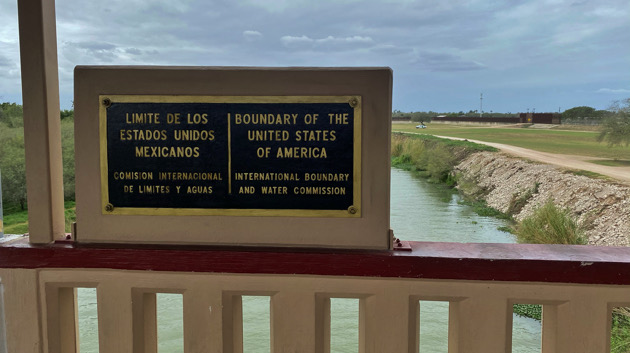(WASHINGTON) — Secretary of State Antony Blinken and Homeland Security Secretary Alejandro Mayorkas outlined plans for reducing the number of migrants at the southern border, expanding restrictive measures and creating new foreign processing centers to direct migrants toward legal pathways for immigration.
The Biden administration will establish regional processing centers throughout Latin America as a way to mitigate the number of migrants heading to the southern border, the Cabinet officials said. These centers will be used to pre-screen individuals to assess eligibility for entry into the United States through refugee resettlement, humanitarian parole programs, family reunification or other lawful pathways.
The plans are intended to blunt an expected surge in migration following the end of a pandemic era policy known as Title 42, which has been used over 2.7 million times to quickly expel migrants with limited opportunities for asylum claims. The policy is expected to end on May 11, when the COVID-19 public health emergency expires.
“Working with our neighbors in the region, we can and will reduce the number of migrants who reach our southern border,” Mayorkas told reporters Thursday. “The regional processing centers announced today will be a critical addition to the programs and processes DHS has in place for qualifying individuals to obtain authorization to enter the United States before arriving at our borders.”
International organizations will oversee the new processing centers, which will be established in several countries like Colombia and Guatemala and in heavily-trafficked areas like the Darien Gap. Migrants will be able to make an appointment on their phones ahead of time before visiting the closest regional processing center.
Blinken focused his remarks on the diplomatic side of the effort, which he called a “global approach” to an “unprecedented migration challenge,” fueled in recent years by elements like the economic unrest caused by the pandemic, turbulent governance and climate change.
“The magnitude, the range of drivers, the push and pull factors, all demand that we work together,” he said.
He urged patience from those hoping to see results quickly, noting that “many of these investments can take time to bear fruit.”
Turning to measures intended to make near-term impacts, Blinken discussed supporting other host countries in providing legal protections and assistance to refugee applicants and countering disinformation spread by traffickers, as well as expanding access to and information about legal pathways.
On a call with reporters on Thursday, senior administration officials said eligible migrants will also be offered options for resettlement in the host countries. The governments of Spain and Canada will also be accepting referrals from the centers, one official said.
Thursday’s joint announcement represents a significant partnership consisting of the State Department, the Department of Homeland Security and countries in the western hemisphere to create a buffer between migrants fleeing their home countries and the southern border of the U.S.
The administration is continuing to add new migration restrictions while opening up new opportunities for those who may qualify for refugee status or asylum. Those restrictions, which have been focused on Cubans, Venezuelans, Haitians and Nicaraguans at the southern border, will now expand to disqualify those who take to the seas to enter the U.S. illegally, Mayorkas said. Authorities have seen more migrants illegally landing in southern Florida on rickety boats.
More broadly, Homeland Security has been working to expand fast-track migrant removals even after Title 42 ends.
Further, the administration is moving forward with its most restrictive policy yet, one that will temporarily penalize asylum seekers if they cross the border illegally. Mayorkas said Thursday these measures are designed to reduce the expected strain on immigration authorities once Title 42 lifts.
“We have been preparing for this transition for more than a year and a half,” Mayorkas said. “Notwithstanding those preparations, we do expect that encounters at our southern border will increase as smugglers are seeking to take advantage of this change and already are hard at work spreading disinformation that the border will be open after that. High encounters will place a strain on our entire system, including our dedicated and heroic workforce and our communities. The smugglers’ propaganda is false.”
During the Thursday call, a senior administration official stressed that the end of Title 42 doesn’t mean the border is open and that migrants who fail to submit eligible claims for asylum will still be processed under the standard immigration processes outlined in Title 8 of the U.S. code.
Prior to the implementation of Tile 42 in 2020, Title 8 was the sole authority through which Customs and Border Protection processed and removed migrants who crossed the border illegally without a legal basis to stay in the country. But the process through which migrants are removed is much slower than the streamlined expulsions that are allowed by Title 42.
Under Title 8, some migrants can request asylum before being removed. In the past, that has created a bottleneck of migrants at CBP processing facilities and border communities. Migrants who are removed under Title 8 are also susceptible to a five-year ban for reentry and may face legal repercussions if they repeatedly attempt to enter the country unlawfully.
As previously reported by ABC, DHS has been beefing up resources at the border, in part, by holding “credible fear” screening interviews for migrants while they’re in CBP custody as opposed to after they’re released.
Migrant encounters by Border Patrol agents increased 25% from February to March of this year, with authorities apprehending or detaining migrants more than 250,000 times during that interval, according to CBP.
Copyright © 2023, ABC Audio. All rights reserved.












